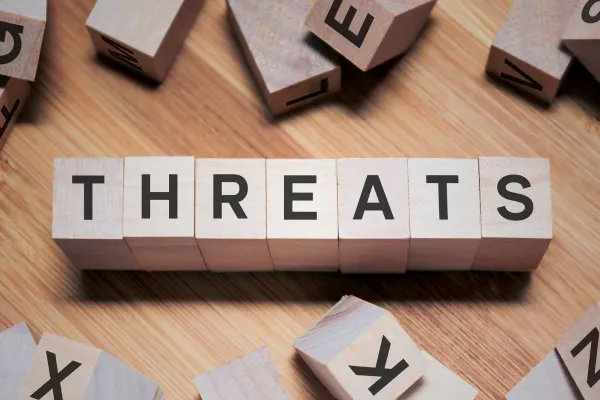Blog & News

Threat Assessment: Proactively Identifying and Mitigating Physical Security Risks
Threat Assessment: Proactively Identifying and Mitigating Physical Security Risks
A comprehensive threat assessment is the foundation of any robust physical security strategy. By systematically identifying potential threats, assessing vulnerabilities, and prioritizing risks, organizations can allocate resources effectively, strengthen defenses, and protect people, assets, and operations. At Steel Bison Security, we specialize in conducting detailed threat assessments tailored to your unique environment. In this blog post, we'll explore what threat assessment entails, why it matters, the key components of the process, proven methodologies, best practices, and how modern tools and technologies can enhance your security posture.
1. What Is a Threat Assessment?
A threat assessment is a structured process that helps organizations:
Identify Assets — Catalog people, property, information, and operational capabilities that need protection.
Recognize Potential Threats — Determine which hazards (natural, criminal, or accidental) could harm those assets.
Evaluate Vulnerabilities — Analyze weaknesses in your physical infrastructure, policies, or procedures.
Assess Risk — Combine threat likelihood with potential impact to quantify risk levels.
Prioritize Mitigation — Rank risks to focus on the most critical gaps first.
Unlike a generic risk overview, a threat assessment dives deep into the specific context of your site—be it a corporate office, warehouse, school, or construction zone—producing actionable insights and a roadmap for targeted security investments.
2. Why Threat Assessments Matter
2.1. Proactive Risk Management
Rather than reacting to incidents after they occur, threat assessments enable proactive measures that prevent or minimize disruptions. This approach reduces downtime, financial losses, and reputational harm.
2.2. Regulatory Compliance
Many industries are governed by safety and security regulations—from the Occupational Safety and Health Administration (OSHA) guidelines for workplace safety to standards by the National Fire Protection Association (NFPA). A thorough threat assessment demonstrates due diligence and helps satisfy audit requirements.
2.3. Cost-Effective Resource Allocation
By prioritizing the highest-risk scenarios, organizations can allocate budget and manpower where they’ll have the greatest impact, avoiding waste on low-priority issues.
2.4. Enhanced Stakeholder Confidence
Customers, investors, and employees feel more secure when they know that potential threats have been identified and mitigated—strengthening trust and business continuity.
3. Key Components of the Threat Assessment Process
3.1. Asset Identification
Inventory: List critical assets (e.g., equipment, networks, intellectual property).
Valuation: Determine the importance of each asset based on cost, operational dependence, or safety impact.
3.2. Threat Identification
Natural Hazards: Earthquakes, floods, severe weather.
Human Threats: Theft, vandalism, workplace violence, cyber-physical attacks.
Accidental Risks: Equipment failures, power outages, contractor errors.
3.3. Vulnerability Analysis
Physical Weaknesses: Poor lighting, unreinforced entry points, outdated locks.
Procedural Gaps: Inadequate visitor screening, lack of emergency drills, unclear responsibilities.
Technological Flaws: Unsupported software, no video analytics, weak alarm configurations.
3.4. Risk Assessment
Likelihood: Estimate how often a threat could materialize (e.g., historical incident data).
Impact: Assess potential consequences (financial loss, injury, service interruption).
Risk Score: Use a simple matrix (e.g., Low/Medium/High) or numerical scale to combine likelihood and impact.
3.5. Risk Prioritization
Heat Maps: Visualize high-risk areas in facility diagrams.
Action Plans: Define short-term (patch vulnerabilities) and long-term (infrastructure upgrades) measures.
Metrics: Establish key performance indicators (KPIs) to track risk reduction over time.
4. Proven Methodologies and Frameworks
4.1. NIST SP 800-30
The National Institute of Standards and Technology’s guide on risk management provides a well-established methodology for threat and vulnerability assessments. Learn more: NIST SP 800-30 Rev. 1.
4.2. ISO 31000
This international standard offers principles and guidelines for effective risk management across any industry. More details at ISO 31000:2018 Risk Management.
4.3. ASIS International Guidelines
ASIS publishes best practices for security professionals, including threat assessment procedures tailored to physical security applications. Explore their resources: ASIS International.
4.4. CARVER Method
Originally developed for military target analysis (Criticality, Accessibility, Recuperability, Vulnerability, Effect, Recognizability), CARVER helps prioritize facilities or assets based on strategic importance and susceptibility.
Each framework can be adapted to your organization’s size, complexity, and regulatory environment. Often, a hybrid approach—combining elements of NIST, ISO, and CARVER—yields the most comprehensive results.
5. Best Practices for Conducting Threat Assessments
5.1. Assemble a Multi-Disciplinary Team
Include stakeholders from operations, IT, facilities management, HR, and executive leadership to ensure that all perspectives and expertise inform the assessment.
5.2. Leverage Data and Historical Incidents
Analyze past security reports, incident logs, insurance claims, and local crime statistics to ground your likelihood estimates in real data.
5.3. Conduct On-Site Surveys and Interviews
Walk the facility with security personnel, maintenance teams, and frontline staff. Their insights into daily operations and “known issues” are invaluable.
5.4. Use Mapping and Visualization Tools
GIS-based software and digital site maps help illustrate asset locations, threat zones, and vulnerability points—making it easier to communicate findings to decision-makers.
5.5. Keep Assessments Current
Facilities, processes, and threat landscapes evolve. Schedule formal reviews at least annually and update risk profiles after major changes—such as new construction, organizational restructuring, or emerging threats.
5.6. Integrate Findings into an Actionable Plan
Translate assessment results into a prioritized roadmap with clear timelines, assigned responsibilities, and budget estimates for each mitigation step.
6. Tools and Technologies to Enhance Threat Assessments
Risk Management Software: Platforms like LogicManager, Resolver, or RiskLens automate data collection, scoring, and reporting.
IoT Sensors & Access Control Analytics: Real-time monitoring of entry points, environmental sensors, and alarm systems feeds live data into your risk dashboard.
Drones and Aerial Imaging: Drones equipped with high-resolution cameras can survey large or hard-to-reach areas for potential vulnerabilities.
Video Analytics: AI-powered analytics detect unusual behavior or unauthorized access patterns, supplementing human patrols.
Mobile Assessment Apps: Tools that allow field personnel to input findings, photos, and GPS data directly into the central assessment tool.
By combining human expertise with technology, your threat assessment process becomes more accurate, efficient, and repeatable.
7. Example Scenario: Office Complex Threat Assessment
Asset Identification: Data center, executive offices, parking garage, HVAC systems.
Threat Analysis: Break-ins after hours, disgruntled employee sabotage, power failure.
Vulnerability Survey: Poor lighting in parking garage, single-factor access to server room, lack of backup power.
Risk Scoring:
Server room breach: High likelihood (insider threat), High impact → High Risk.
Parking garage break-ins: Medium likelihood, Medium impact → Medium Risk.
Mitigation Plan:
Upgrade server room access to biometric controls and install uninterruptible power supplies (UPS).
Improve lighting and install CCTV with analytics in the garage.
Schedule quarterly review of access logs and conduct employee awareness training.
This structured approach ensures that resources are focused on the most critical areas first.
8. How Steel Bison Security Can Help
At Steel Bison Security, we offer end-to-end threat assessment services that include:
On-Site Risk Surveys: Our specialists conduct thorough walkthroughs, interviews, and data reviews to capture every potential vulnerability.
Custom Risk Models: We tailor risk-scoring matrices and frameworks to align with your industry standards and organizational goals.
Actionable Roadmaps: Receive a detailed mitigation plan with prioritized recommendations, cost estimates, and implementation timelines.
Technology Integration: We help select and deploy the right combination of software, sensors, and analytics tools to support ongoing risk monitoring.
Training & Workshops: Equip your team with the knowledge to recognize emerging threats and maintain a vigilant security posture.
Learn more about our tailored solutions on our services page or get in touch via our contact page.
9. Conclusion
A well-executed threat assessment provides clarity on where your organization is most vulnerable and how to allocate resources effectively. By following proven methodologies, leveraging multidisciplinary expertise, and integrating modern tools, you can transform raw data into a strategic security roadmap. Whether you manage an office complex, manufacturing plant, educational campus, or any other facility, regular threat assessments ensure that emerging risks are identified and mitigated before they become costly incidents.
Partner with Steel Bison Security to build a proactive, data-driven threat assessment program that safeguards your people, assets, and reputation—today and into the future.
Implementing a structured threat assessment is the first step toward building resilient and adaptive security strategies. Embrace best practices, leverage technology, and work with experts to stay ahead of evolving threats.

EMAIL ADDRESS
OFFICE NUMBER
OFFICE ADRESS
(WA) 11900 NE First St STE 3066, Bellevue, Wa 98005
(WY) 30 N. Gould St STE R, Sheridan, Wy 82801
Copyright 2024 Steel Bison Security Services
